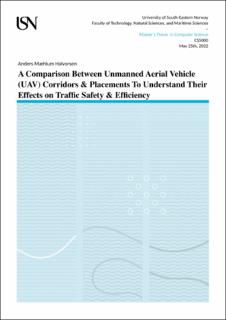| dc.description.abstract | With the increasing interest and utilization of unmanned aircraft, also known as drones, current predictions and simulations of the future airspace have found that the existing approach toward drone operation is not sufficient to ensure traffic safety. To cope with the future demand, structuring the airspace has been found beneficial and necessary. Accordingly, various structuring concepts have been proposed, with various concepts suggesting the adaptation of drone corridors. Drone corridors are similar to roads and highways and provide rules of engagement to navigate and improve traffic safety. Understanding how different corridor types, rules, parameters, and placements affect the efficiency and safety of the traffic are all crucial areas of research to improve and influence the future structuring of the airspace. Therefore, in this thesis, we have explored different corridor types, rules, parameters, and placements to observe beneficial characteristics for traffic efficiency and safety. By conducting fast-time simulations with randomized traffic within the metropolitan area of Paris, we observed from our simulational results that structuring the airspace with the utilization of drone corridors significantly improved traffic safety compared to current high-density operations. Moreover, we observed that layering the corridor airspace into different layers is beneficial for the safety and efficiency of the traffic. We further discovered that by assigning similar drone specifications to the same layers, the efficiency of the traffic increased by allowing more optimal speeds and altitudes. We noticed that a lower separation distance of 20 meters amongst drones increased efficiency and safety. Similarly, we found that a higher base speed limit of 18 m/s increased traffic efficiency and safety. On the other hand, no significant efficiency or safety benefit was observed with the increase or decrease in lookahead time. Finally, a significant contrast in the efficiency and safety of the trafficwas observed for different corridor placements. It was observed that a more spread-out corridor placement with a higher number of junctions improved the safety and efficiency of the traffic. | en |
